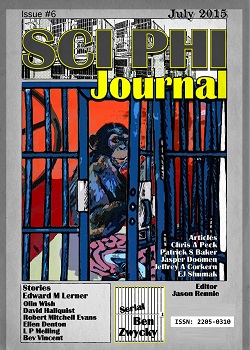 Sci Phi Journal #6, July/August 2015
Sci Phi Journal #6, July/August 2015
Reviewed by Chuck Rothman
Sci Phi Journal is a newish magazine dedicated to publishing stories with a philosophical bent. The July issue contains seven stories intended to make the reader think of deeper ideas.
“There’s an App for That” has the narrator traveling on the DC Metro and feeling old: the things he was used to have all been replaced with technology and he’s feeling melancholy about it. Edward M. Lerner‘s story is ultimately a complaint about the pace of change and how things just aren’t the way they used to be. It’s OK, but really doesn’t say much other than have a cute pun at the end.
Ellen Denton‘s “The Frankenstein Project” tells of Dr. Andrea Silas, one of the team working on transplanting a brain into a cybernetic body. The technology seems all there, and succeeded with Lucy, a chimp, whose mind is now successfully housed in a robot body. But Andrea senses a problem, and soon discovers that the experiment has gone horribly wrong. The story is well written, but it’s only content to present the idea behind it. It’s powerful enough, but I would like to see how the idea actually affects people.
“A Bottle of Red Zinfandel” by Bev Vincent shows Abby coming home to her husband Shane with the bottle of wine in the title. It turns out to be stolen, using Abby’s new invention—a working teleportation device. Most of the story has the two discussing the ramifications of that ability. The big problem with it is that it is just two people discussing a single idea. Isaac Asimov occasionally used this format, but Asimov knew enough to throw in a few twists so the conversation didn’t just confirm what was said in the beginning. The characters of Abby and Shane are well drawn, at least, but there’s no drama here and the idea is laid out from the start and merely confirmed.
David Hallquist indulges in some awful infodump in the start of his story “Whispers”: eleven long paragraphs that are completely unnecessary. Then comes a ton of description before we actually get to the story: William Malcom is alone on the seemingly abandoned Charon Station, gateway to the stars. But he hears voices and whispers that shouldn’t be there. Ultimately the solution is a well-worn concept that’s been part of science fiction for decades, presented as though no one has ever written about it before. It doesn’t help that Malcom is not a particularly interesting character.
Olin Wish shows Thomas Jefferson-Escobar, a teen student aboard a generation ship heading toward the planet that is the story title, “TN-3970,” which carries what’s left of humanity away from Earth. Tommy is your ultimate bored teenager, who doesn’t care about the mission or the lessons being taught on the final exam. The story consists of Tommy answering the test questions, all asking about the life on the new world. It’s an interesting way of presenting the information, but Tommy is a pretty one-note character and this reads like a setup for a longer story, with an ending that leaves plenty of loose ends hanging.
“The Story is a Lie” has Fatima, a Muslim woman, trekking to Timbuktu after some unnamed ecological disaster. Robert Mitchell Evans‘s story is strong on the details of the city and on the description of Fatima’s faith and struggle to keep going. It ends, however, with a demon ex machina that seems almost tacked on to make it science fiction.
Lee Melling‘s “Stunted Relive E-Loop” is a story that’s almost as opaque as its title. Eric Blair (I’m trying to decide if that name was chosen to reference George Orwell; if so, the connection is tenuous) is a student studying for a major exam, only to find those words. The whole thing has a touch of Groundhog Day in it and the ending doesn’t resolve anything (or even explain what’s going on) and seems to be saying far less than it thinks it is.
While the magazine is a great concept for science fiction, the issue is the execution. It doesn’t help to have a “Food for Thought” section after each story that reads like a high school textbook. One even asks the ever-popular question of college freshmen everywhere: “What is reality?” Others are only tangentially related to the story, and others seem to me to be a stretch. The cliché is that science fiction is the literature of ideas, but there needs to be more focus on drama (and the stories that do focus on drama and character are the best here) and less on “isn’t this a neat idea?”
Chuck Rothman’s novels Staroamer’s Fate and Syron’s Fate are available from Fantastic Books. He has a story in the anthology Temporally Out of Order.